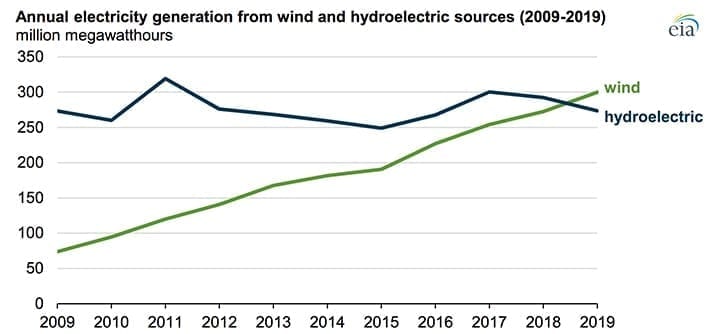The Year Wind Surpassed Hydro as the Top Renewable in the U.S.
Annual wind power generation exceeded hydroelectric generation for the first time in 2019, according to data published by the U.S. Energy Information Administration (EIA) on Feb. 26, making wind the top-producing renewable source of electricity in the country, a position long held by hydro.
The EIA’s Electric Power Monthly with Data for December 2019 report shows wind power production from utility-scale facilities totaled 300.071 TWh last year, while conventional hydropower facilities produced 273.707 TWh (Figure 1). Solar production was a distant third on the renewables list, tallying 69.017 TWh from utility-scale photovoltaic systems, although the solar total increases to 107.275 TWh when small-scale and solar thermal facilities are added in.

The U.S. also surpassed the 100-GW threshold in installed wind capacity in 2019. The American Wind Energy Association (AWEA), the national trade association of the U.S. wind energy industry, reported that 9,143 MW was added to the nation’s wind power portfolio in 2019, bringing the total installed capacity to 105,583 MW at year-end. There was particularly strong growth in the fourth quarter of the year, as developers installed 35 new wind projects totaling 5,476 MW in 16 states.
“The demand and growth of U.S. wind energy can’t be understated,” AWEA CEO Tom Kiernan, said in a press release. “Today, there are nearly 60,000 wind turbines spinning across 41 states powering the equivalent of over 32 million American homes. Demand for wind energy is greater than ever as evidenced by corporations and utilities signing contracts in record numbers. Nearly 200 projects are underway in 33 states from the wind belt in America’s heartland to the booming offshore wind market, where visionary leaders are leveraging the affordable, clean energy that wind provides.”
Although hydro capacity has remained very stable for years, annual hydroelectric generation has fluctuated between 250 TWh and 320 TWh over the past decade. Variations in annual precipitation and water runoff are the main factors affecting hydropower production. Weather patterns also affect wind, of course, but capacity growth has been the predominant driver of annual changes in wind power generation.
—Aaron Larson is POWER’s executive editor (@AaronL_Power, @POWERmagazine).